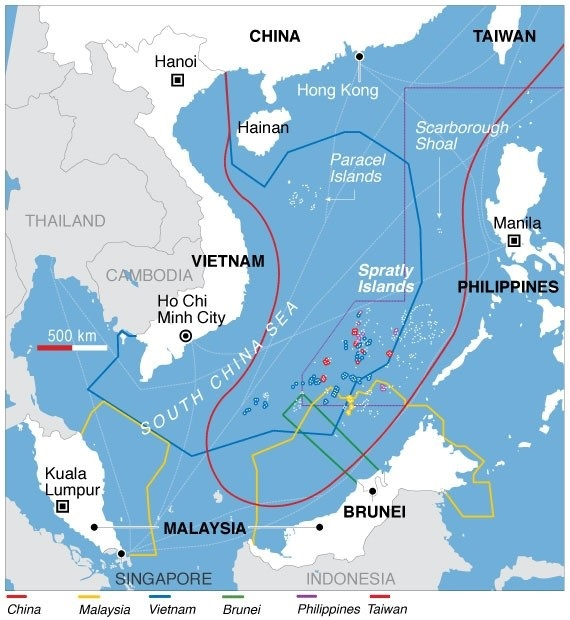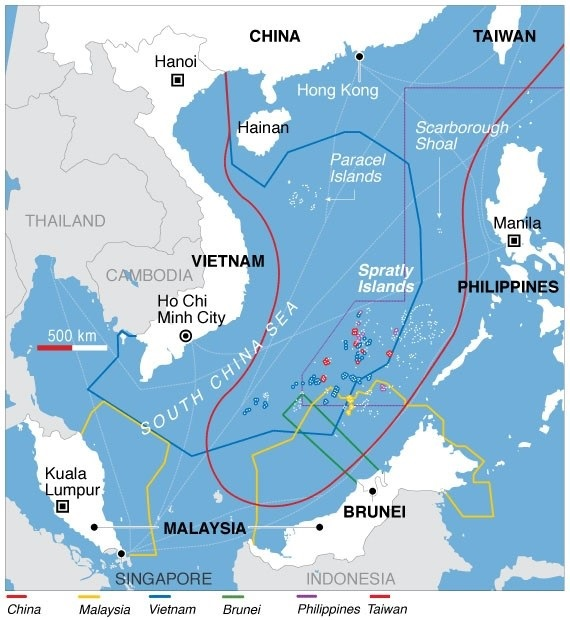Great gesture by Shah Rukh Khan to Sunny Deol Amid Cold War
- 12-05-2020
- News

The South China Sea, one of the world’s busiest waterways, is subject to several recurring territorial confrontations involving China, Taiwan, Vietnam, the Philippines, and Malaysia amongst others. With international support to the disputed region, it has now become a major point of conflict between US and China. A recent couple of weeks saw the US Navy exercising two aircraft carrier strike groups in it. The UK has also intimated that its new £3 billion aircraft carrier HMS Queen Elizabeth will sail in the South China Sea next year, exercising with American and Japanese warships. According to sources, this deployment is aimed to counter the increasingly aggressive threat of China.
What is South China Sea?
The "South China Sea" as referred by International Hydrographic Organization (IHO) is a marginal sea within Pacific Ocean spread over 3.5 million km². States and territories with borders on the sea (clockwise from north) include:
It is one of the most strategically important body of water in the world, it being world’s second most used seaway with one-third of the world's shipping passing through it, carrying over $3 trillion trade annually. This body of water holds one third of the entire world's marine biodiversity making it ecologically significant besides being a source of profitable seafood for those sharing its shore with it. The bottom of this sea holds vast proven oil reserves of around 1.2 km³ (7.7 billion barrels), with an estimate of 4.5 km³ (28 billion barrels) in total and Natural gas reserves are estimated to total around 7,500 km³ (266 trillion cubic feet).
What is it disputed?
Because of its economic importance and geological placement, South China Sea dispute is one of the oldest, unresolved and potentially dangerous conflict of humankind encompassing three different issues: disputes over claimed territory, disputes over claimed waters, and disputes over the types of maritime activities that are permissible in these waters under international law. States sharing their territories with the disputed sea wants hold of fishing stocks, right to explore crude oil and natural gas in the seabed, and control over important shipping lanes. To be specific, the disputes include the islands, reefs, banks, and other features of the South China Sea, some of those witnessing recurring military confrontations being the Spratly Islands, Paracel Islands, Mischief Reef and Scarborough Shoal.

During World War II, when the South China Sea region was not claimed by anyone, the Imperial Japanese Navy took over its control and used it for military operations. But after the war was over, it had to renounce its control as part of 1951 Treaty of San Francisco. The Imperial Japan however failed to establish control of a specific country over the sea and that is when the dispute started. When the Communist Party of China took over mainland China and formed the People's Republic of China in 1949, the nine-dotted line map was adopted which encompasses almost the entire South China Sea Region including islands. Brunei, Malaysia, the Philippines, and Vietnam claims only a portion of seabed around their geographical boundaries with the South China Sea. However, both China and Taiwan claims almost the entire body as their own, establishing it within what is known as the nine-dotted line.

China's claim over these nine-dotted lines does not have any legal origin and specific coordinates. It has been widely rejected by Vietnam, Indonesia, the Philippines, and the United States, and has been criticized by numerous international scholars.
2011 agreement and South China Sea Code of Conduct
On 20 July 2011, the PRC, Brunei, Malaysia, the Philippines, Taiwan and Vietnam agreed a set of preliminary guidelines on the implementation of the DOC (Declaration of Conduct of Parties in the South China Sea) which would help resolve their disputes. In May 2017, China and the ten member states of the Association of Southeast Asian Nations (ASEAN) announced that they have finalized a framework for a code of conduct for the disputed South China Sea. The Code of Conduct (COC) that would establish safety and freedom of navigation in the South China Sea despite competing territorial claims is scheduled for completion in 2022.
The 2016 Verdict
In January 2013, the Philippines formally initiated arbitration proceedings against China's claim on the territories within the nine dotted lines. On July 12, 2016, the Permanent Court of Arbitration established that there is “no legal basis for China to claim historic rights" over the nine-dotted lines. The tribunal also criticized China's efforts to dominate the waterway by constructing artificial islands in the Spratly Islands, saying that it had caused "severe harm to the coral reef environment". Both China and Taiwan rejected this ruling.
International Support and Risks
Since 2015, the United States, France and the United Kingdom have started conducting freedom of navigation operations (FONOP) in the region in order to establish and ensure free and open access of to the South China Sea to everyone. Since May 2017, the United States has conducted six FONOPs in the region. Increasing number of encounters have intensified the risk of Beijing and Washington accidentally engaging into armed confrontation.
As far as India’s stance on the situation is concerned, as clarified by Indian Navy “India supports freedom of navigation in international waters, including in the South China Sea, and the right of passage in accordance with accepted principles of international law. These principles should be respected by all”. India supports the United States for resolution of territorial and maritime disputes in the Indo-Pacific region as per international law, notably United Nations Convention for the Law of the Sea (UNCLOS). Recently Indian foreign ministry spokesman Anurag Srivastava said that the South China Sea was “part of global commons and India has an abiding interest in peace and stability in the region”.